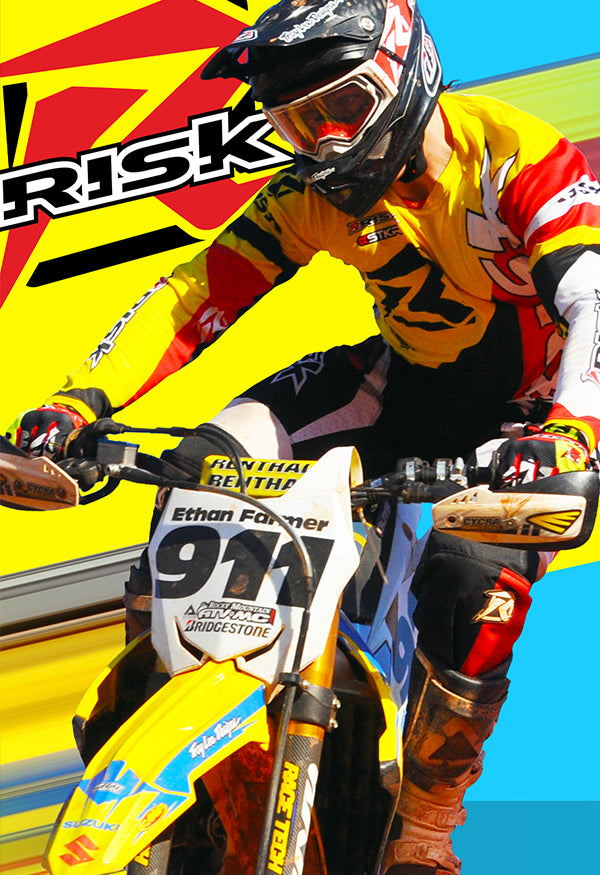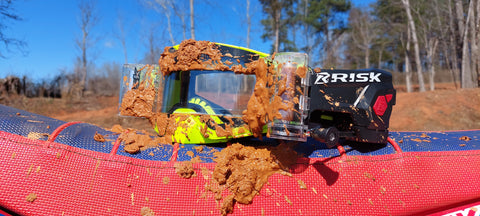Ihr Warenkorb ist leer
MOTO Products
shop your way
Choose a shopping experience
Same great Risk Racing products, 3 completly different ways to shop them.
Choose a shopping experience
Same great Risk Racing products, 3 completly different ways to shop them.

Lifestyle Shopping

eComm Shopping

Catalog Shopping
MOTO TYRES
MOTO Gear & Apparel
Necessities for Riding Dirt Bikes in Wet Conditions
August 26, 2022 5 min lesen.

A dirt bike is a thrill-packed ride on a warm summer's day, but riders quickly realize how vital safety equipment can be when dancing in the rain. And I'm not just talking about the basics like a helmet, boots, and a chest protector. Before you start mud biking, you need to get a few wet conditions must-haves:
A goggle cleaning system like the Ripper Auto Roll-Off paired with the JAC V3 Goggles with roll-off lenses is necessary for riding dirt bikes in wet conditions. Mud grips keep handlebars dry to maintain control and avoid arm pump. A multi-pronged mud-removal tool (like Mud Axe) is a must-have for cleaning your bike during (and after) riding.
Keep reading as we explore the four necessities of riding dirt bikes on wet trails, and tracks including:
- An automated goggle roll-off system
- Goggles with high visibility and tear-off/roll-off lenses
- Portable mud-removal accessory
- Grip slide-ons for better control over wet handles
1. Ripper Automated Roll-Off System
Your highest priority on the dirt bike should be to protect yourself, and to ride safely you need clear vision and high quality protective equipment. As long as you control these two factors, every risk is manageable.
In wet conditions, dirt is more diluted and can splash high with a large splatters and chunks that will inhibit vision. Not to mention the roost from other riders! There's nothing more annoying, and potentially dangerous than taking your hands off the handlebar to clean your goggles.
Riders can eliminate the annoyance and risk factor of taking hands of the bars to clear vision with The Ripper. Which is the best and only universal automated Goggle Roll-Off System!
This Ripper automated goggle cleaner likely works with whichever roll-off goggles you already have for your dirtbike riding (check out the compatibility chart here).
Its battery life supports ten full roll-off rolls on average! And the Ripper is rechargeable, so you don't have to worry about buying new batteries every few rolls. There are different modes that aim to clear your goggles in 1 second or less.
2. JAC V3 Goggles
If you don't want to risk getting a goggle cleaning system just to discover that the roller doesn't fit your goggles, you can get RISK Racing's JAC V3 Goggles.
These goggles are designed to maintain clear visibility when dirt biking. Everything from the size of the lens to the curvature of the lens is designed around rider ergonomics, comfort, and field of view.
You have two options to ensure visibility in wet conditions while wearing JAC V3 Goggles.
- The first is to use to use the goggles with the roll-off lens they come with, which is also compatible with The RIPPER.
- The second is to opt for tear-off lenses that are compatible with J.A.C. V3 Frames to remove the mud with the the tear-offs.
3. Mud Axe
Mud Axe is the swiss army knife of mud scraping for any gear that comes in contact with mud.
Why use the Mud Axe:
- Shave weight off your bike between motos from mud or well prepped that sticks to your bike.
- Clean the bulk of the mud off your bike before leaving the track so it doesn't harden on your way home making it difficult to get off.
- The Mud Axe has a pick on one end so you can get mud out of tight and intricate areas like pegs, shifter, rear brake etc...
The Mud Axe allows you to wipe/scrape, pick at clogs, and scoop around the curvature of wheels and hubs.
Cleaning off the mud can take so much time that the fun of riding is ruined by thinking about how much time you'll need to wipe away all the mud.
4. Mud Grips
Riding a dirt bike in wet conditions entails gripping the handles despite being slick. We grab the handles tighter for better control and don't even notice the strain this puts on our muscles.
If you have experienced pump from handle gripping, you know the importance of having a dry handle that is rough enough to control easily.
Mud Grips help you maintain control over your dirt bike's grips even when they get wet and muddy. These grips feel dry even on the nastiest trails. They disperse mud efficiently whenever there is an unfortunate splash and keep a "nearly" dry surface.
You can slide these onto your dirt bike handles whenever the conditions are wet or keep them on all the time. After all, they are designed to have almost zero detectable thickness.
BONUS: How to Overcome the 3 Main Challenges of Riding a Dirt Bike in Wet Conditions
The necessities above are important, but you can still ride in the rain without them...it's just going to be quite inconvenient.
Understanding the challenges of wet conditions will enable you to gear up better for dirt biking when the tracks are drenched.
Lack of Control:
When excessive moisture hits the ground, traction goes out the door. There are two points where one can lose control while riding a bike:
- At the wheels
- At Rider contact points i.e. grips, pegs, and seat
The first point is beneath the bike, i.e., the ground. If the bike's tires aren't designed for the conditions or the tread is worn down, the bike can slide and fall, especially around sharp turns and off camber sections.
The handles of your dirt bike are the second and more vulnerable point of control loss.
If the bike grips are too wet to hold firmly, your hand can start slipping. In best cases, you get arm pump and fatigue from clenching too hard. In worse ones, you lose your grip on a jump or turn.
Mud Grips prevent both these outcomes.

Poor Visibility:
While still water is clear, splashing water reduces visibility. Mix it with dirt...and you have the perfect recipe for blindness.
Dirt bike riders must roll off the mud from their goggle lens every few minutes when the mud is thin enough to splash higher than three feet.
In the best-case scenario, mud splashes don't obstruct your view. In most cases, you have to take your hands off the handles to reclaim your vision. And in some cases, you might have to stop your bike or crash because you can't see anything.
Tear-off lenses and automatic goggle cleaning contraptions can help you avoid this fate.
Clogging:
Where most motorbikes can't handle muddy terrain, dirt bikes are impressively resilient in wet conditions. This has to do with the protective design of dirt bikes that can stand up to splashing.
But that's only to an extent.
In the wettest scenarios mud can clog the radiators causing bikes to overheat, or get between the rotor and bake pads inhibiting braking.
Mudguards and frequent cleaning with a tool like the Mud Axe can keep your bike from getting mud-clogged.

Schreiben Sie einen Kommentar
Kommentare werden vor der Veröffentlichung genehmigt.
Subscribe
Sign up to get the latest on sales, new releases and more …

Limited Time 10% Off
Save on your 1st order and get email offers when you join.
Eligible for first-time website purchases only. Emails may take a few minutes to process and could get flagged by email providers as junk so be sure to wait a little bit and check your junk and/or spam folders.

 UK / EU▾
UK / EU▾

































